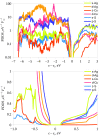Band Structure, Phonon Spectrum and Thermoelectric Properties of Ag3CuS2
- PMID: 36770135
- PMCID: PMC9919962
- DOI: 10.3390/ma16031130
Band Structure, Phonon Spectrum and Thermoelectric Properties of Ag3CuS2
Abstract
Sulfides and selenides of copper and silver have been intensively studied, particularly as potentially efficient thermoelectrics. Ag3CuS2 (jalpaite) is a related material. However very little is known about its physical properties. It has been found that the compound undergoes several structural phase transitions, having the tetrahedral structural modification I41/amd at room temperature. In this work, its band structure, phonon spectrum and thermoelectric properties were studied theoretically and experimentally. Seebeck coefficient, electrical conductivity and thermal conductivity were measured in a broad temperature range from room temperature to 600 K. These are the first experimental data on transport properties of jalpaite. Ab initio calculations of the band structure and Seebeck coefficient were carried out taking into account energy dependence of the relaxation time typical for the scattering of charge carriers by phonons. The results of the calculations qualitatively agree with the experiment and yield large values of the Seebeck coefficient characteristic for lightly doped semiconductor. The influence of intrinsic defects (vacancies) on the transport properties was studied. It was shown that the formation of silver vacancies is the most probable and leads to an increase of hole concentration. Using the temperature dependent effective potential method, the phonon spectrum and thermal conductivity at room temperature were calculated. The measurements yield low lattice thermal conductivity value of 0.5 W/(m K) at 300 K, which is associated with the complex crystal structure of the material. The calculated room temperature values of the lattice thermal conductivity were also small (0.14-0.2 W/(m K)).
Keywords: Seebeck coefficient; electric conductivity; jalpaite; thermal conductivity; thermoelectric properties.
Conflict of interest statement
The authors declare no conflict of interest.
Figures















References
-
- Slack G.A. New Materials and Performance Limits for Thermoelectric Cooling. CRC Press; Boca Raton, FL, USA: 1995. pp. 407–440. CRC Handbook of Thermoelectrics. Chapter 34.
-
- Yu B., Liu W., Chen S., Wang H., Wang H., Chen G., Ren Z. Thermoelectric properties of copper selenide with ordered selenium layer and disordered copper layer. Nano Energy. 2012;1:472–478. doi: 10.1016/j.nanoen.2012.02.010. - DOI
-
- Okimura H., Matsumae T., Makabe R. Electrical properties of Cu2-xSe thin films and their application for solar cells. Thin Solid Films. 1980;71:53–59. doi: 10.1016/0040-6090(80)90183-2. - DOI
-
- Mane R., Kajve S., Lokhande C., Han S.H. Studies on p-type copper (I) selenide crystalline thin films for hetero-junction solar cells. Vacuum. 2006;80:631–635. doi: 10.1016/j.vacuum.2005.08.021. - DOI
LinkOut - more resources
Full Text Sources

